ignition CHEVROLET ASTRO PASSENGER 1994 1.G Owners Manual
[x] Cancel search | Manufacturer: CHEVROLET, Model Year: 1994, Model line: ASTRO PASSENGER, Model: CHEVROLET ASTRO PASSENGER 1994 1.GPages: 340, PDF Size: 16.86 MB
Page 38 of 340
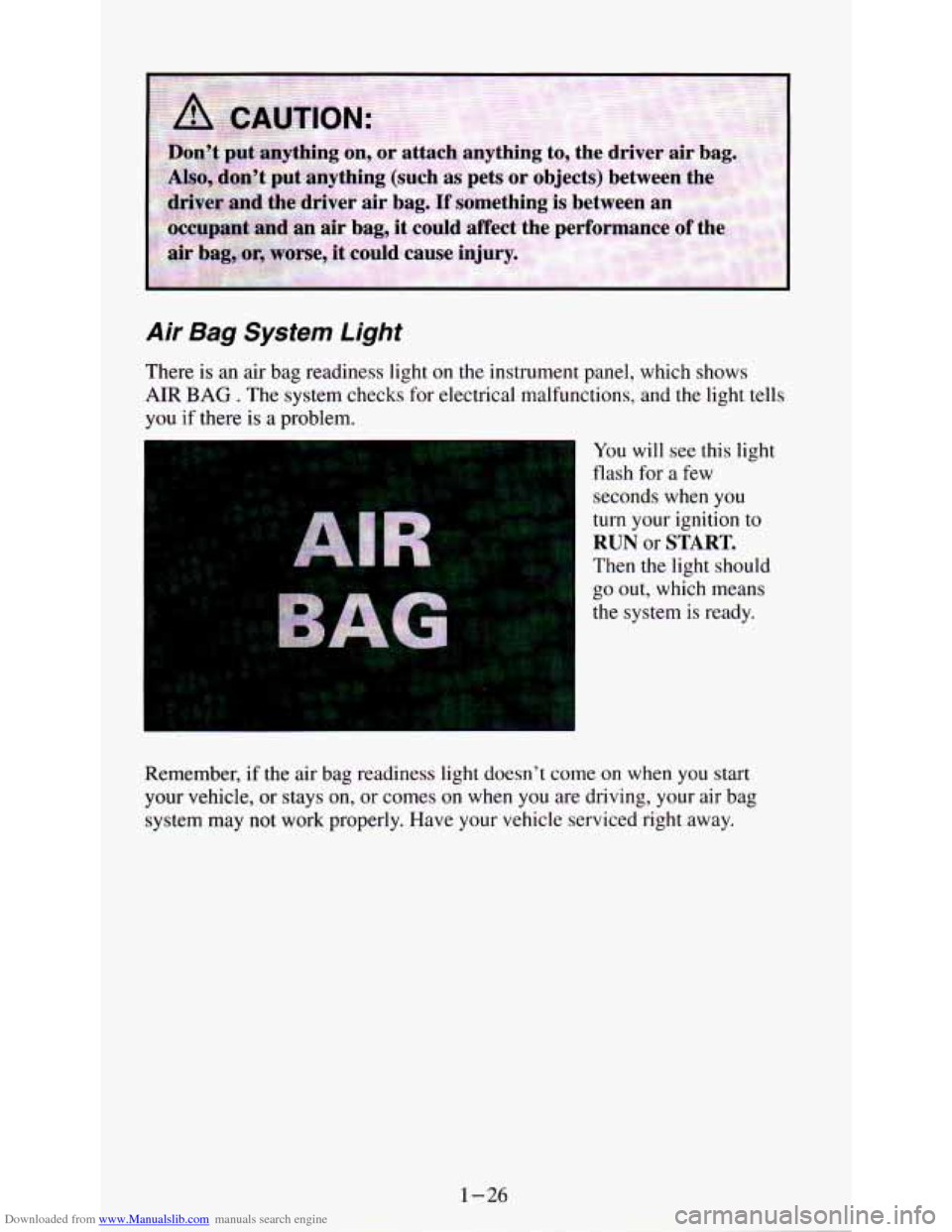
Downloaded from www.Manualslib.com manuals search engine Air Bag System Light
There is an air bag readiness light on the instrument panel, which shows
AIR BAG . The system checks for electrical malfunctions, and the light tells
you if there is a problem.
You
will see this light
flash for a few
seconds when
you
turn your ignition to
RUN or START.
Then the light should
go out, which means
the system is ready.
Remember, if the air bag readiness light doesn’t come on when
you start
your vehicle, or stays on,
or comes on when you are driving, your air bag
system may
not work properly. Have your vehicle serviced right away.
1-26
Page 61 of 340
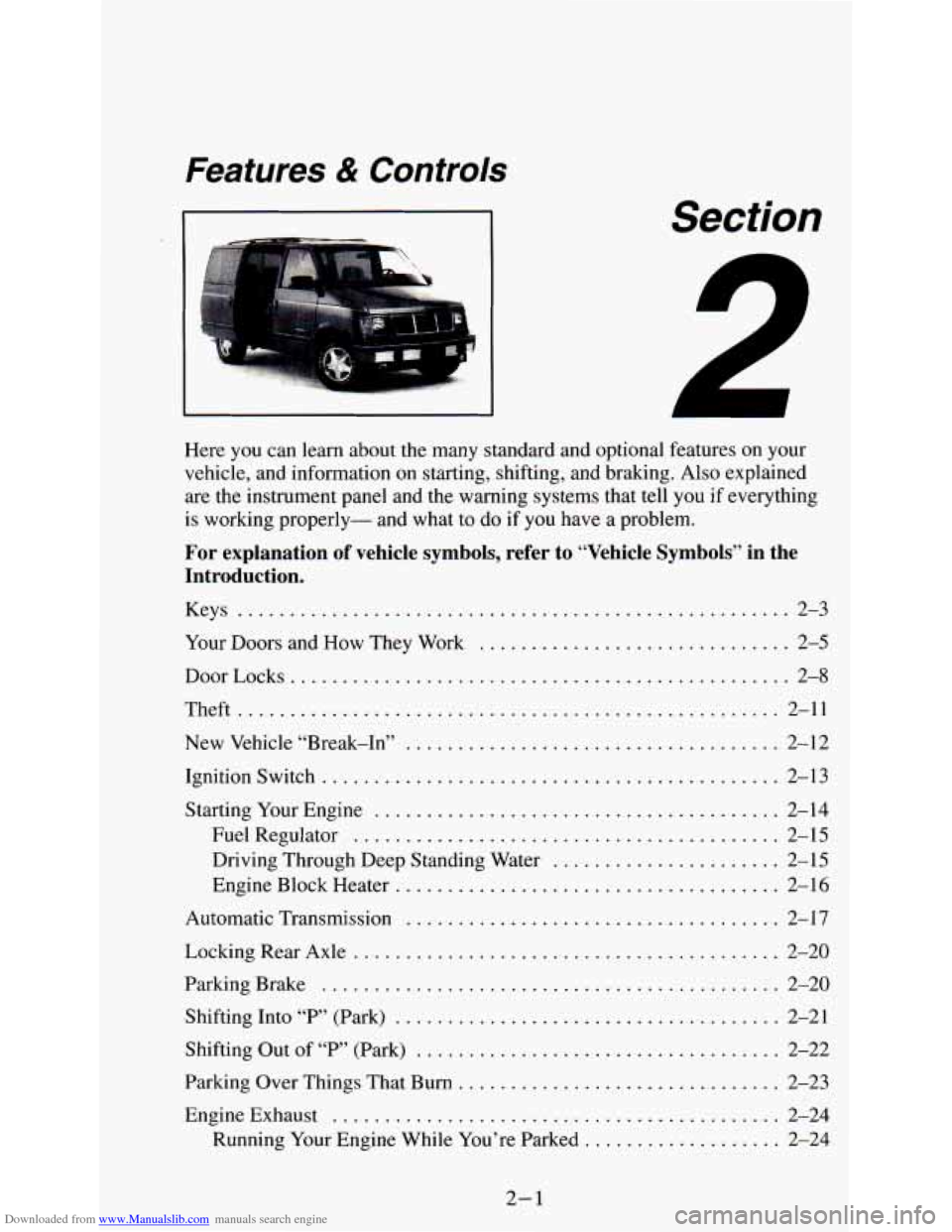
Downloaded from www.Manualslib.com manuals search engine Features & Controls
Section
A
..
Here you can learn about the many standard and optional features on your
vehicle. and information on starting. shifting. and braking
. Also explained
are the instrument panel and
the warning systems that tell you if everything
is working properly- and what to
do if you have a problem .
For explanation of vehicle symbols. refer to “Vehicle Symbols” in the
Introduction
.
Keys ................................. .................. 2-3
Your Doors and How They Work
..................... ....... 2-5
DoorLocks
................................................ 2-8
Theft
..............................................
New Vehicle “Break-In” ................. .......
. . 2-11
. . 2-12
Ignition Switch
....... ....... .......................... 2-13
Starting Your Engine
....................................... 2-14
FuelRegulator
......................................... 2-15
Driving Through Deep Standing Water
... ............... 2-15
Automatic Transmission
.................................... 2-17
Engine
Block Heater
................................... 2-16
.. ..< .. Locking Rear Axle ...................... .... 2-20
ParkingBrake
............................................ 2-20
Shifting Into
“P’ (Park) ....... .......................... 2-21
Shifting Out of “P” (Park)
................................... 2-22
Parking Over Things That Burn
............................... 2-23
EngineExhaust
.....................................
Running Your Engine While You’re Parked .............
.... 2-24
. . 2-24
2-1
Page 72 of 340
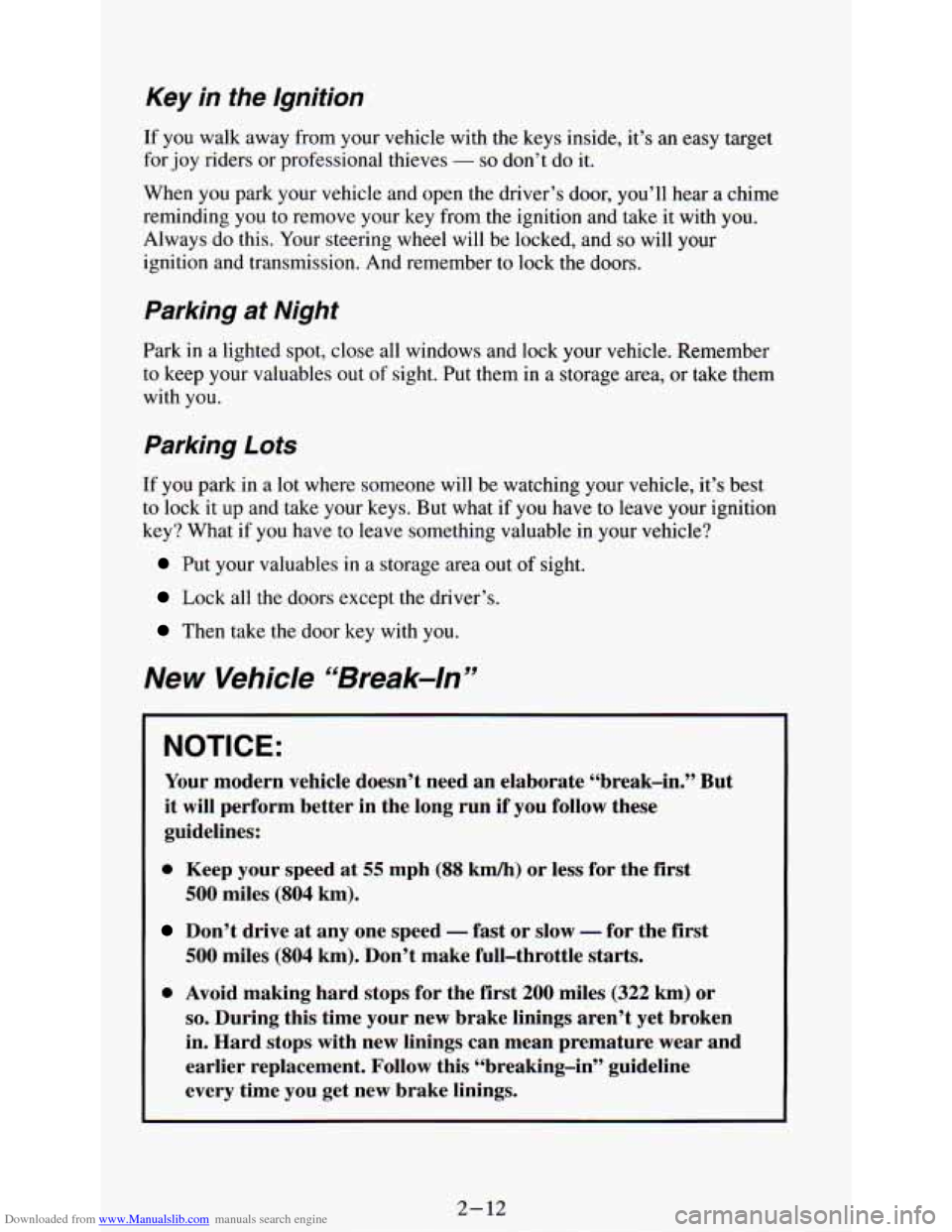
Downloaded from www.Manualslib.com manuals search engine Key in the Ignition
If you walk away from your vehicle with the keys inside, it’s an easy target
for joy riders or professional thieves
- so don’t do it.
When you park your vehicle and open the driver’s door, you’ll hear
a chime
reminding you to remove your key from the ignition and take it with you.
Always do this. Your steering wheel
will be locked, and so will your
ignition and transmission. And remember to lock the doors.
Parking at Night
Park in a lighted spot, close all windows and lock your vehicle. Remember
to keep your valuables out
of sight. Put them in a storage area, or take them
with you.
Parking Lots
If you park in a lot where someone will be watching your vehicle, it’s best
to lock
it up and take your keys. But what if you have to leave your ignition
key? What
if you have to leave something valuable in your vehicle?
Put your valuables in a storage area out of sight.
Lock all the doors except the driver’s.
Then take the door key with you.
New Vehicle “Break-In ”
NOTICE:
Your modern vehicle doesn’t need an elaborate “break-in.” But
it will perform better in the long run if you follow these
guidelines:
0 Keep your speed at 55 mph (88 km/h) or less for the first
500 miles (804 km).
Don’t drive at any one speed - fast or slow - for the first
500 miles (804 km). Don’t make full-throttle starts.
0 Avoid making hard stops for the first 200 miles (322 km) or
so. During this time your new brake linings aren’t yet broken
in. Hard stops with new linings can mean premature wear and
earlier replacement. Follow this “breaking-in” guideline
every time you get new brake linings.
2-12
Page 73 of 340
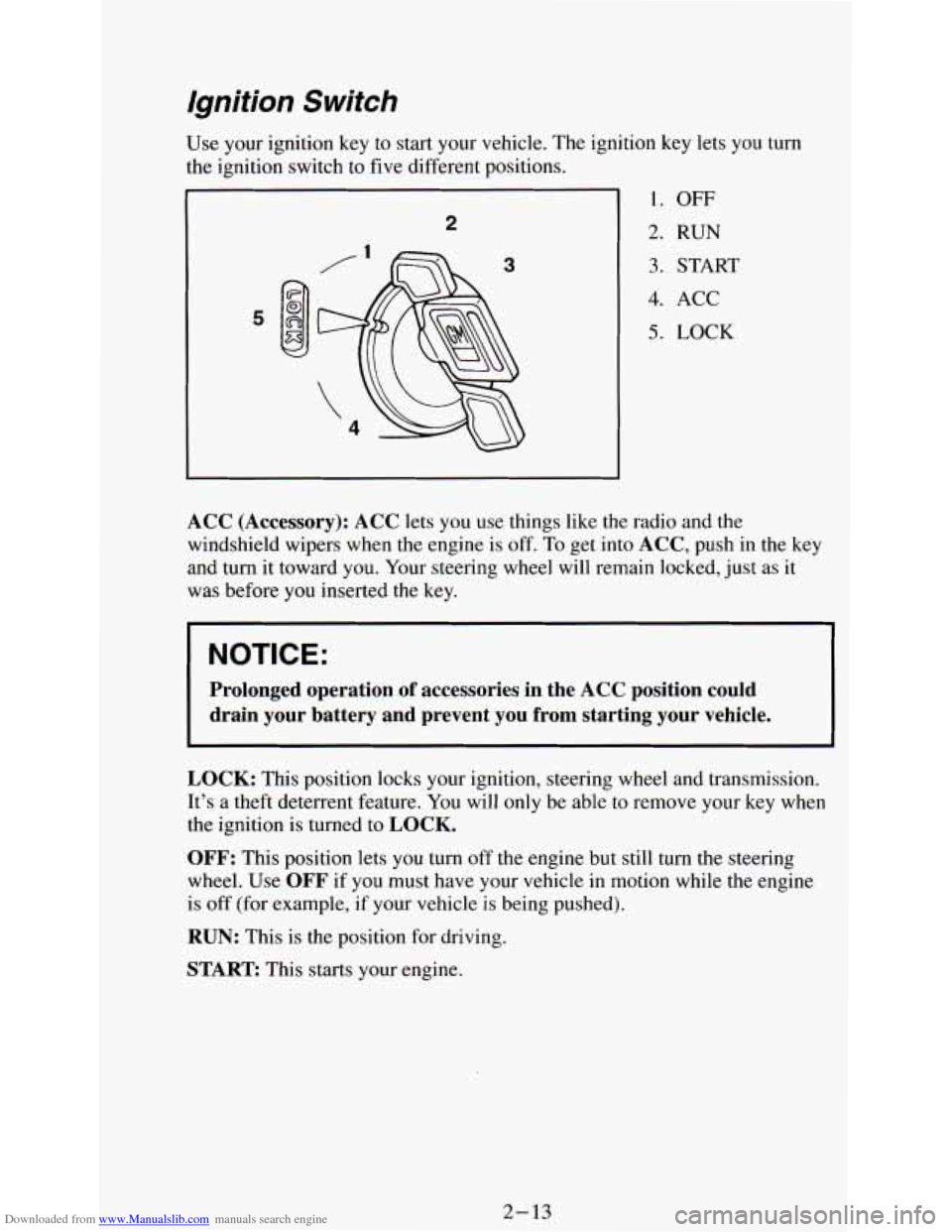
Downloaded from www.Manualslib.com manuals search engine Ignition Switch
Use your ignition key to start your vehicle. The ignition key lets YOU turn
the ignition switch to five different positions.
3
1. OFF
2. RUN
3. START
4. ACC
5. LOCK
ACC (Accessory): ACC lets you use things like the radio and the
windshield wipers when the engine is off. To get into
ACC, push in the key
and turn it toward you. Your steering wheel will remain locked, just as it
was before you inserted the
key.
NOTICE:
Prolonged operation of accessories in the ACC position could
drain your battery and prevent you from starting your vehicle. \
LOCK:
This position locks your ignition, steering wheel and transmission.
It’s a theft deterrent feature. You will only be able to remove your key when
the ignition is turned to
LOCK.
OFF: This position lets you turn off the engine but still turn the steering
wheel. Use
OFF if you must have your vehicle in motion while the engine
is off (for example, if your vehicle is being pushed).
RUN: This is the position for driving.
START This starts your engine.
2-13
Page 74 of 340
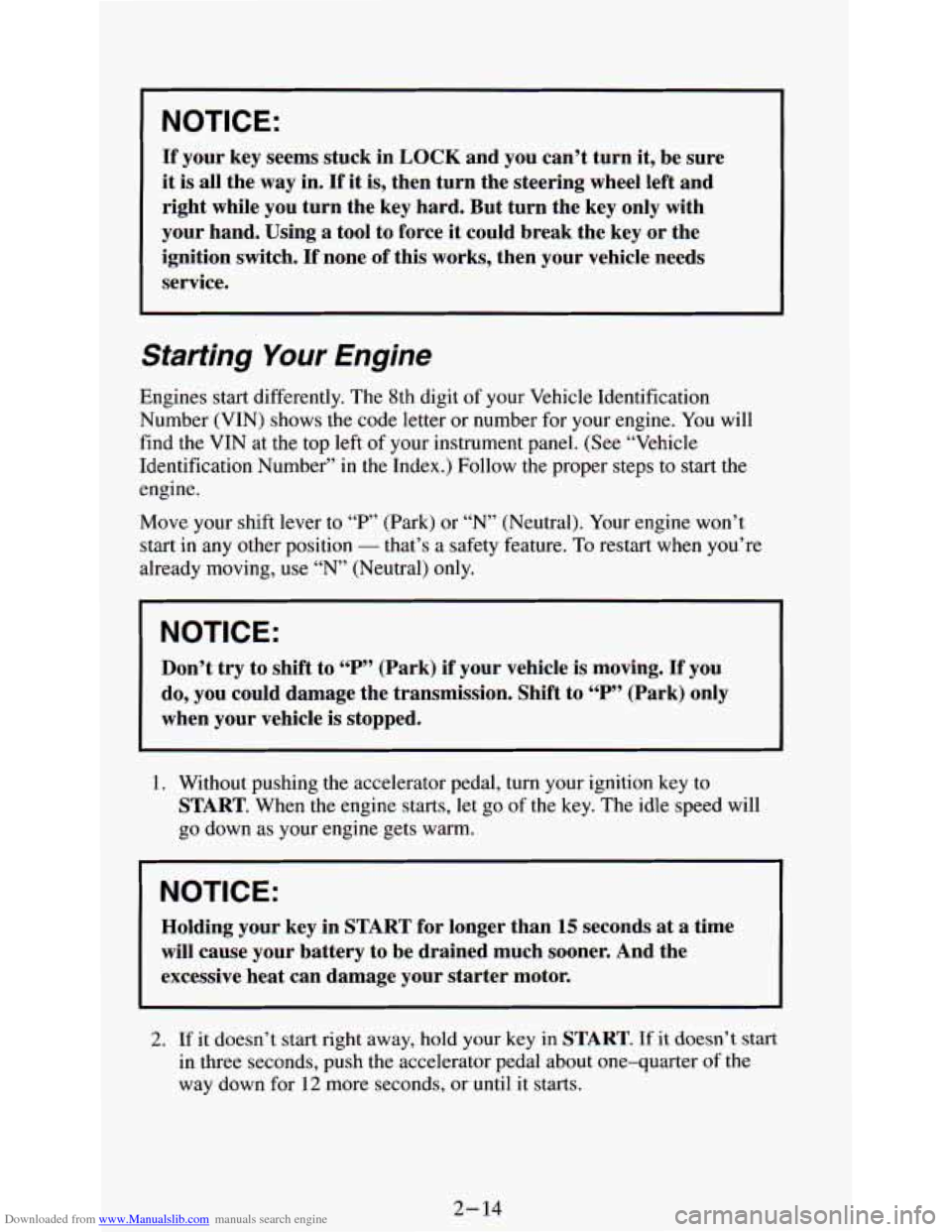
Downloaded from www.Manualslib.com manuals search engine I 1
I NOTICE:
If your key seems stuck in LOCK and you can’t turn it, be sure
it is
all the way in. If it is, then turn the steering wheel left and
right while you turn the key hard. But turn the key only with
your hand. Using
a tool to force it could break the key or the
ignition switch.
If none of this works, then your vehicle needs
service.
Farting Your Engine
Engines start differently. The 8th digit of your Vehicle Identification
Number (VIN) shows the code letter or number for your engine. You will
find the VIN at the top left of your instrument panel. (See “Vehicle
Identification Number”
in the Index.) Follow the proper steps to start the
engine.
Move your shift lever to
“P’ (Park) or “N” (Neutral). Your engine won’t
start in any other position
- that’s a safety feature. To restart when you’re
already moving, use
“N” (Neutral) only.
NOTICE:
Don’t try to shift to “P” (Park) if your vehicle is moving. If you
do, you could damage the transmission. Shift
to “P” (Park) only
when your vehicle
is stopped.
1. Without pushing the accelerator pedal, turn your ignition key to
START. When the engine starts, let go of the key. The idle speed will
go down as your engine gets warm.
NOTICE:
Holding your key in START for longer than 15 seconds at a time
will cause your battery to be drained much sooner. And the
excessive heat can damage your starter motor.
2. If it doesn’t start right away, hold your key in START. If it doesn’t start
in three seconds, push the accelerator pedal about one-quarter of the
way down for
12 more seconds, or until it starts.
2- 14
Page 78 of 340
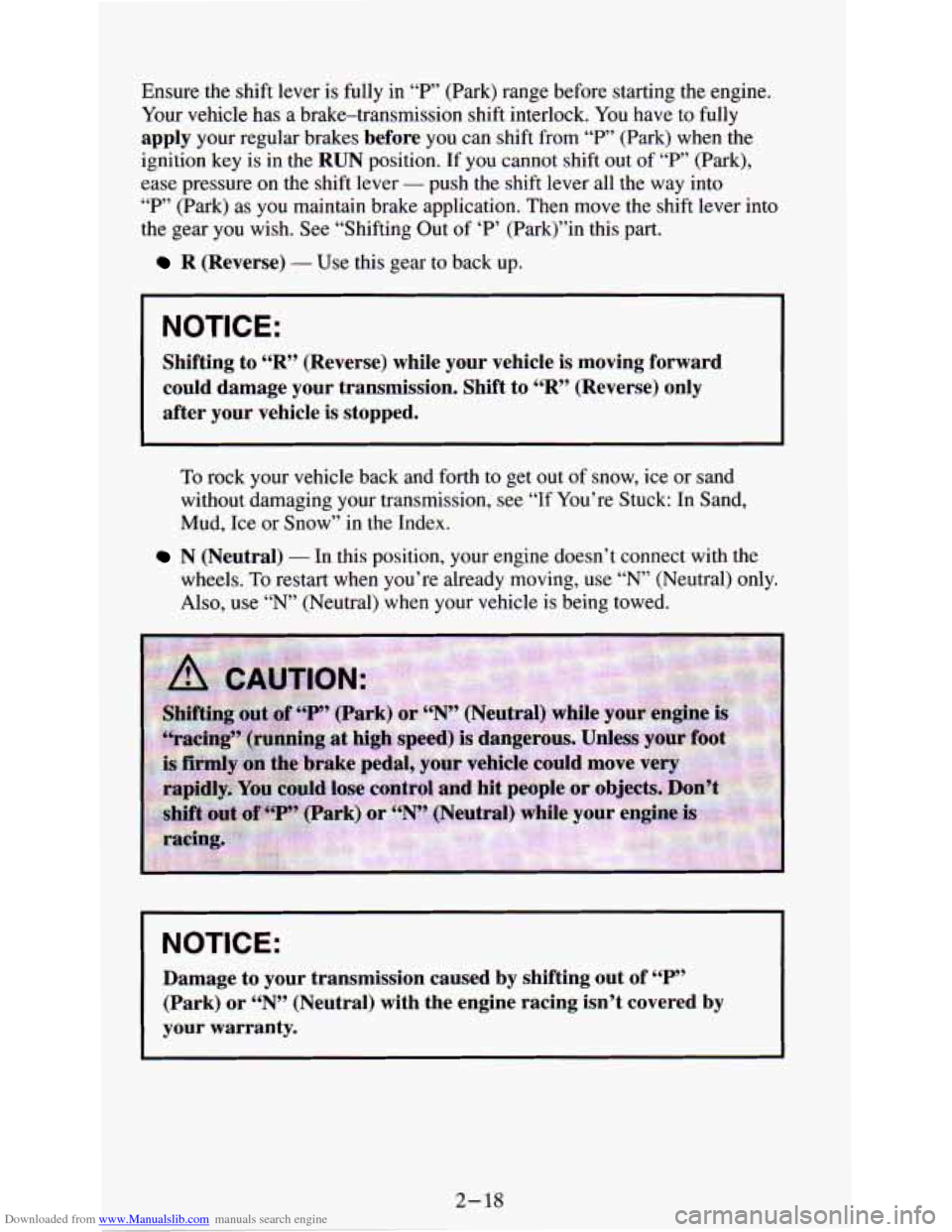
Downloaded from www.Manualslib.com manuals search engine Ensure the shift lever is fully in “P” (Park) range before starting the engine.
Your vehicle has
a brake-transmission shift interlock. You have to fully
apply your regular brakes before you can shift from “P” (Park) when the
ignition key is in the
RUN position. If you cannot shift out of “P’ (Park),
ease pressure on the shift lever
- push the shift lever all the way into
“P” (Park)
as you maintain brake application. Then move the shift lever into
the gear you wish. See “Shifting Out of ‘P’ (Park)”in this part.
R (Reverse) - Use this gear to back up.
NOTICE:
Shifting to “R” (Reverse) while your vehicle is moving forward
could damage your transmission. Shift to
“R” (Reverse) only
after your vehicle is stopped.
To rock your vehicle back and forth to get out of snow, ice or sand
without damaging your transmission, see
“If You’re Stuck: In Sand,
Mud, Ice
or Snow” in the Index.
N (Neutral) - In this position, your engine doesn’t connect with the
wheels. To restart when you’re already moving, use
“N’ (Neutral) only.
Also, use
“N” (Neutral) when your vehicle is being towed.
-
NOTICE:
Damage to your transmission caused by shifting out of “P”
(Park) or “N” (Neutral) with the engine racing isn’t covered by\
your warranty.
1
2- 18
Page 80 of 340
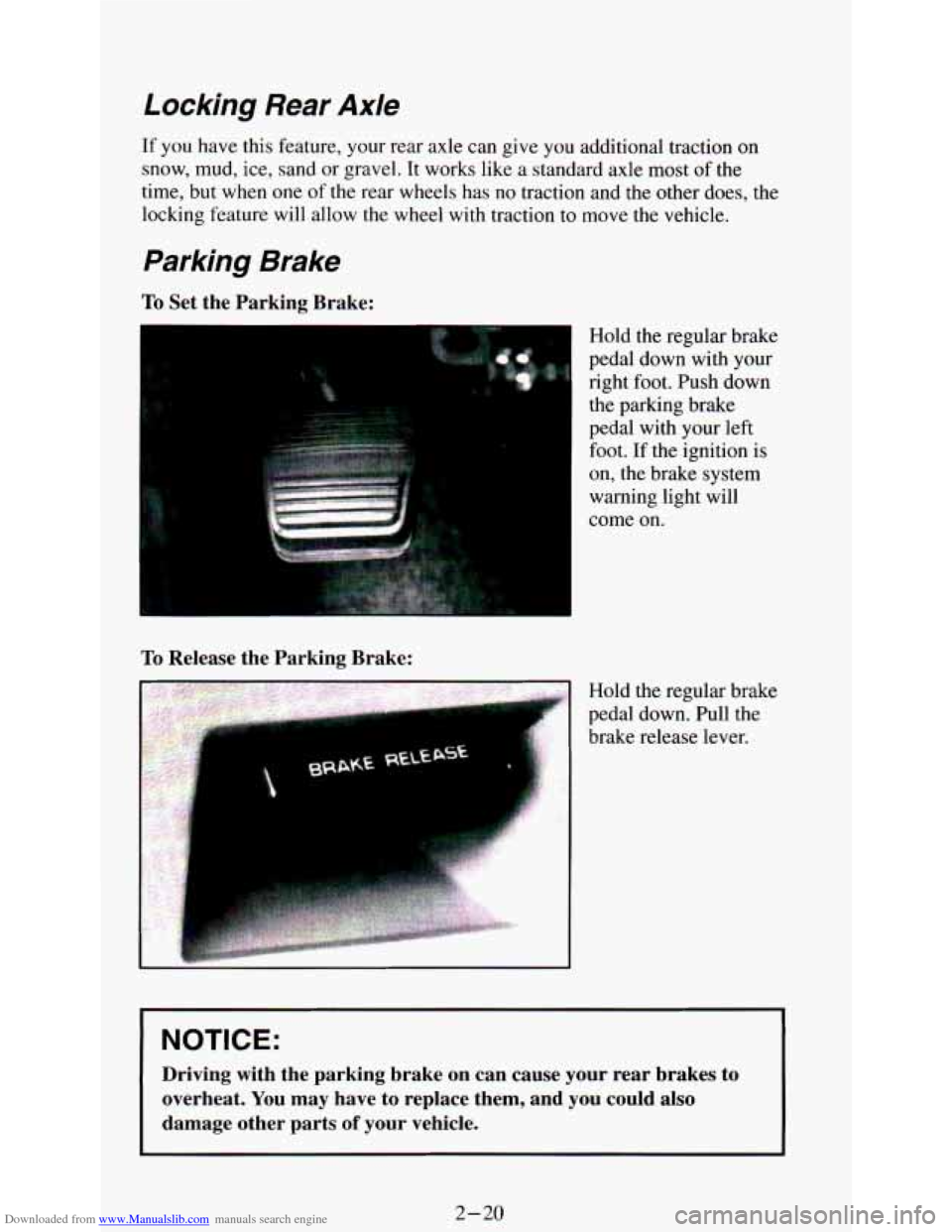
Downloaded from www.Manualslib.com manuals search engine Locking Rear Axle
If you have this feature, your rear axle can give you additional traction on
snow, mud, ice, sand or gravel. It works like a standard axle most of the
time, but when
one of the rear wheels has no traction and the other does, the
locking feature will allow the wheel with traction
to move the vehicle.
Parking Brake
To Set the Parking Brake:
I
I
Hold the regular brake
pedal down with your
right foot. Push down
the parking brake
pedal with your left
foot.
If the ignition is
on, the brake system
warning light will
come on.
To Release the Parking Brake:
Hold the regular brake
pedal down. Pull the
brake release lever.
NOTICE:
Driving with the parking brake on can cause your rear brakes \
to
overheat. You may have to replace them, and you could also
damage other parts
of your vehicle.
2-20
Page 81 of 340
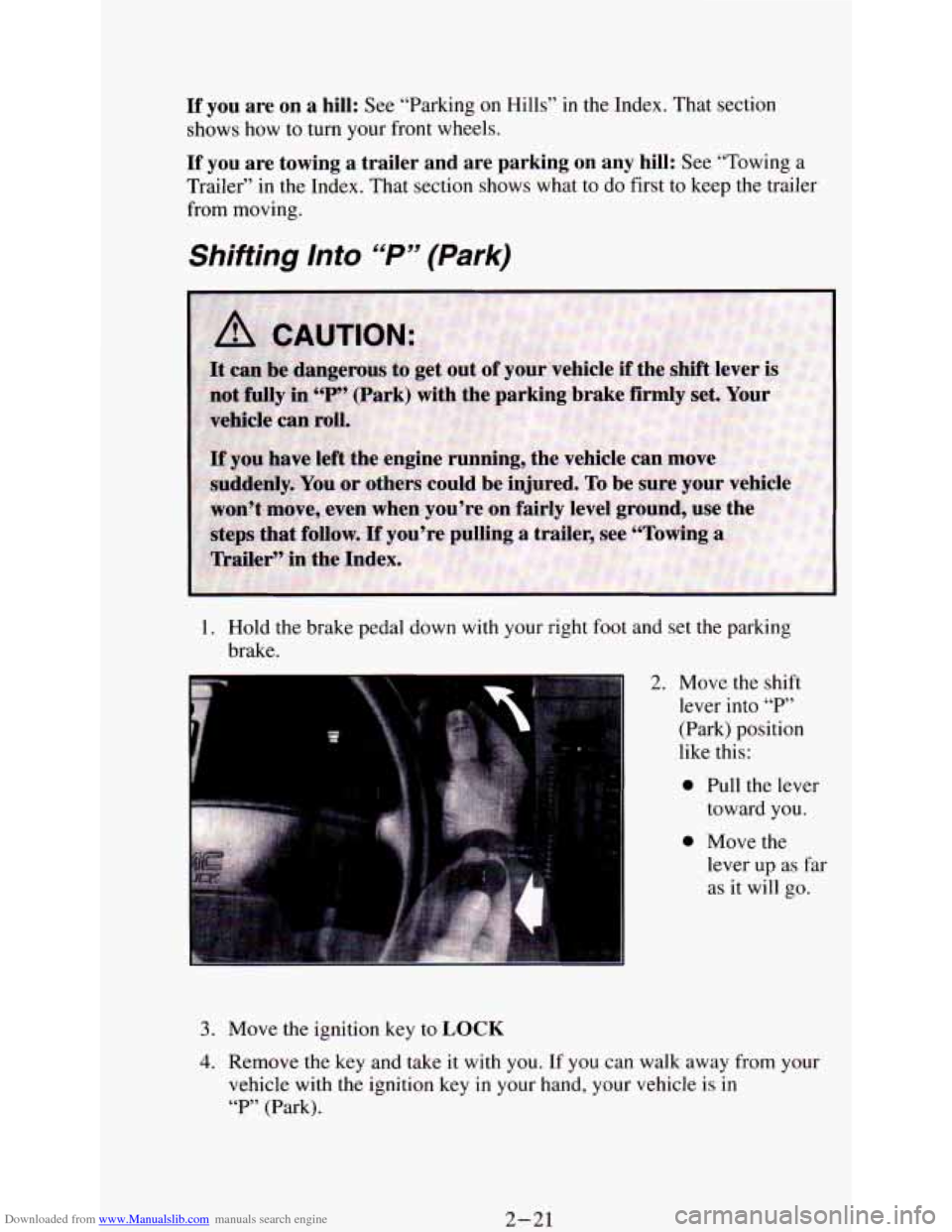
Downloaded from www.Manualslib.com manuals search engine If you are on a hill: See “Parking on Hills” in the Index. That section
shows how to turn your front wheels.
If you are towing a trailer and are parking on any hill: See “Towing a
Trailer” in the Index. That section shows what to do first to keep the trailer
from moving.
Shifting lnto “Pyy (Park)
1. Hold the brake pedal down with your right foot and set the parking
brake.
3. Move the ignition key to LOCK
2. Move the shift
lever into
“P’
(Park) position
like this:
0 Pull the lever
toward you.
0 Move the
lever up
as far
as it will go.
4. Remove the key and take it with you. If you can walk away from your
vehicle with the ignition key
in your hand, your vehicle is in
“P” (Park).
2-21
Page 82 of 340
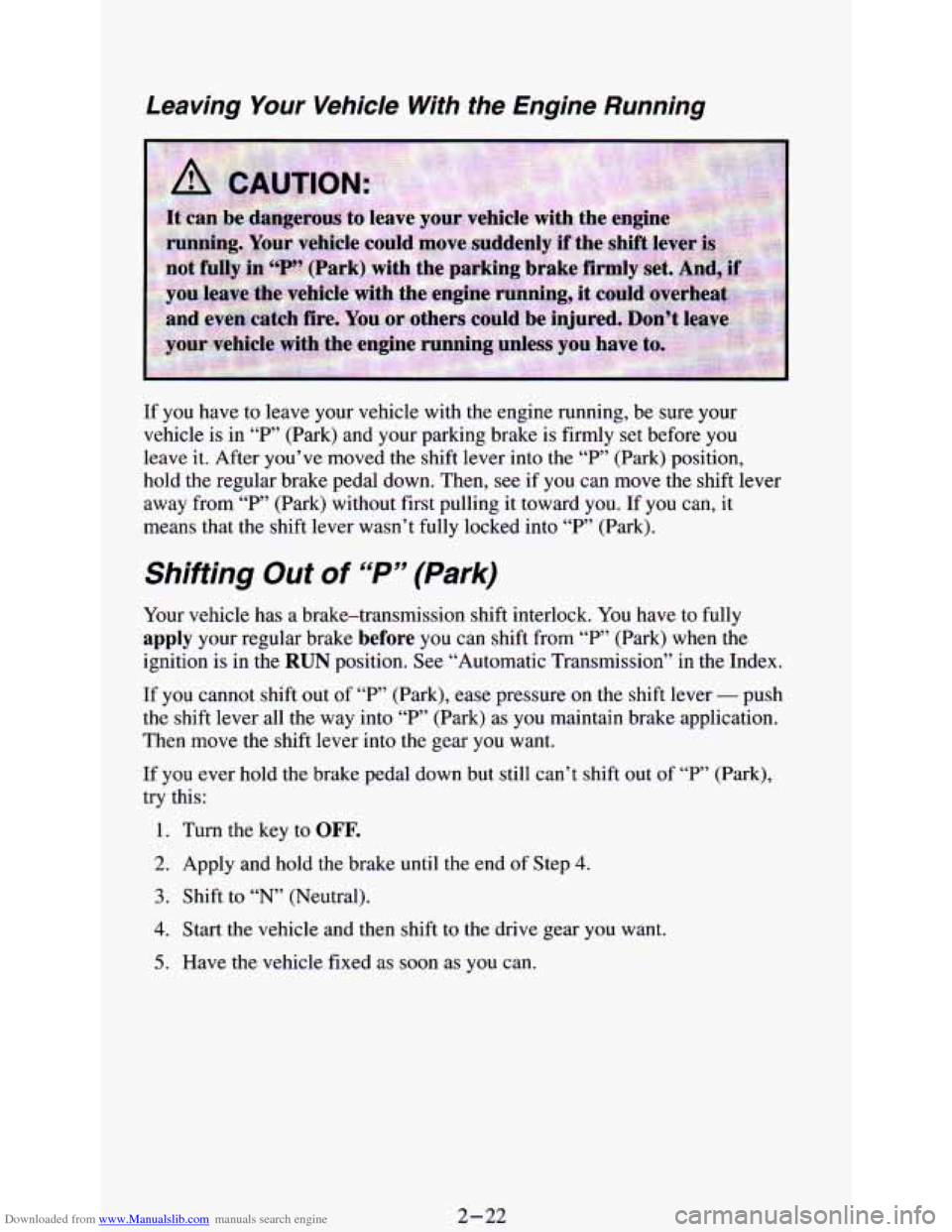
Downloaded from www.Manualslib.com manuals search engine Leaving Your Vehide With the Engine Running
If you have to leave your vehicle with the engine running, be sure your
vehicle is in “P” (Park) and your parking brake is firmly set before you
leave it. After you’ve moved the shift lever into the
“P” (Park) position,
hold the regular brake pedal down. Then, see if you can move the shift lever
away from
“F’” (Park) without first pulling it toward you. If you can, it
means that the shift lever wasn’t fully locked into
“P” (Park).
Shifting Out of “P” (Park)
Your vehicle has a brake-transmission shift interlock. You have to fully
apply your regular brake before you can shift from “P” (Park) when the
ignition is in the
RUN position. See “Automatic Transmission” in the Index.
If you cannot shift out of
“P” (Park), ease pressure on the shift lever - push
the shift lever all the way into
“P” (Park) as you maintain brake application.
Then move the shift lever into the gear you want.
If you ever hold the brake pedal down but still can’t shift out of “P” (Park),
try this:
1. Turn the key to OFF.
2. Apply and hold the brake until the end of Step 4.
3. Shift to “N’ (Neutral).
4. Start the vehicle and then shift to the drive gear you want.
5. Have the vehicle fixed as soon as you can.
2-22
Page 87 of 340
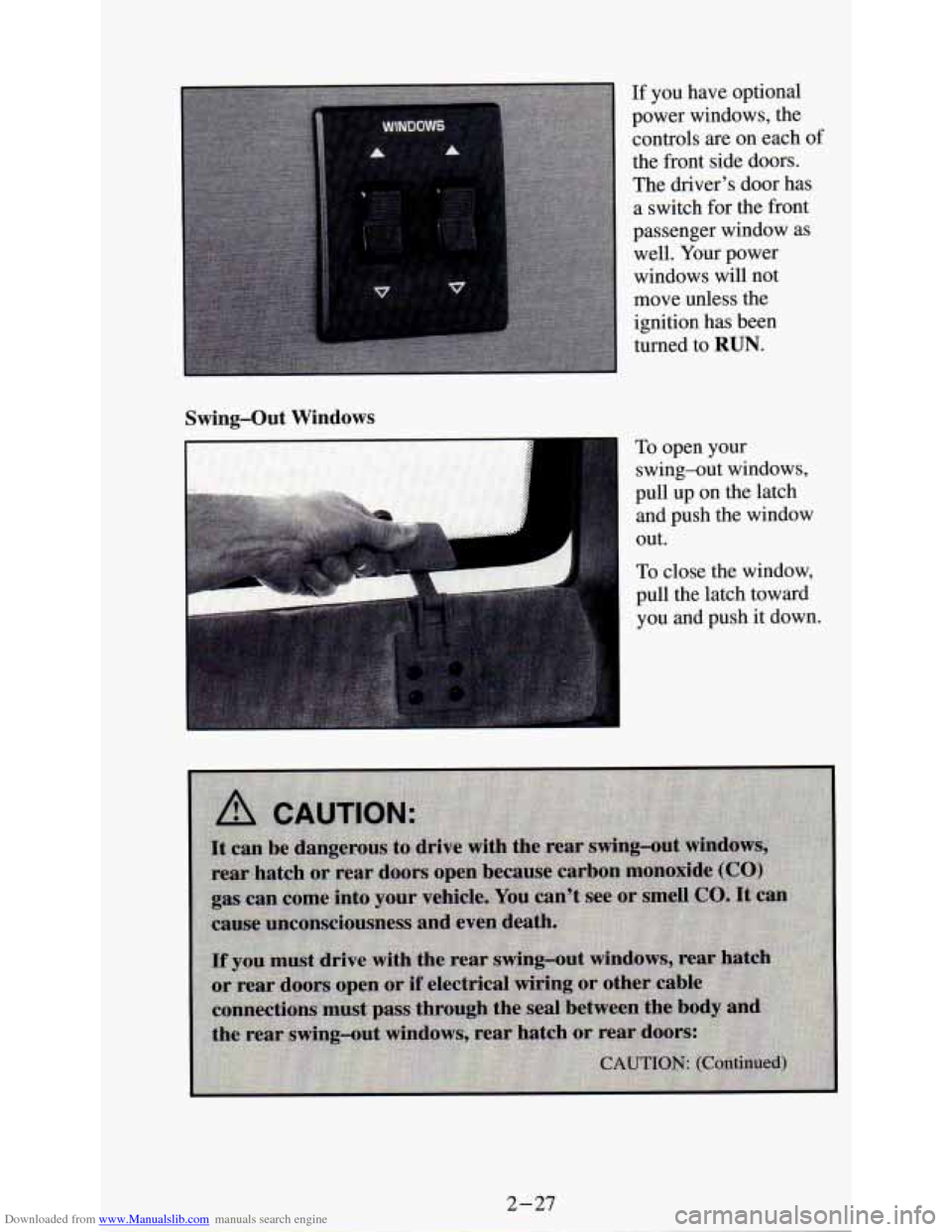
Downloaded from www.Manualslib.com manuals search engine If you have optional
power windows, the
controls are on each
of
the front side doors.
The driver’s door has
a switch for the front
passenger window
as
well. Your power
windows will not
move unless the
ignition has been
turned to
RUN.
Swing-Out Windows
To open your
swing-out windows,
pull up on the latch
and push the window
out.
To close the window,
pull the latch toward
you and push it down.